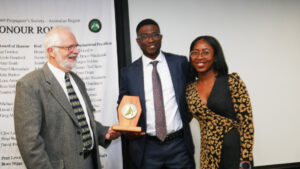
Propagation – essential to life
By Karen Smith
The 51st conference of the International Plant Propagators Society (IPPS) held recently at the Novotel, Geelong in Victoria was awash with the enthusiasm of up-and-coming horticulturists ready to take advantage of the seek and share attitude that is the society’s main purpose.
Garden City Plastics should be proud of their support team of young horticulturists who were part of the machine that kept the conference running smoothly. The help they provided did not go unnoticed and I’m sure the networking opportunities were invaluable. As Jane Edmanson, the popular national broadcaster pointed out, horticulture is an industry that embraces participants with a wide range of skills and abilities, and provides not only employment opportunities but can build and promote communities. Jane is an enthusiastic promoter of seek and share philosophy, especially the share.
The strength of any IPPS conference is the range of attendees and presenters. Botanic gardens were well represented, as were the science community, educators, landscape design, and representatives from the industries that support propagation and horticulture generally. The IPPS provides the opportunity for the complete spectrum of the industry to come together and present problems and solutions. From modern day Planthunter, Alistair Watt who shared his experiences from the past thirty years exploring many countries around the Pacific Rim, to Dr Josekutty (Jose), Agricultural Biotechnologist who educated the audience on Propagating for Farms using micro propagation.
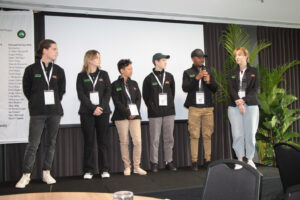
Two presenters, Peter Lewis and Danielle Saintpierre, provided extreme examples with problem sites that were being revegetated.
Danielle Saintpierre works for SIRAS Pacifique (Société Internationale de Réhabilitation et d’Aménagement des Sites). She outlined the work being done to re-establish the environment after the destruction caused by mining. Since 1993 SIRAS Pacifique has trialled various native and exotic plants, as well as engineering methods, to revegetate the sites. Steep slopes are tiered or supported by retaining structures and areas are seeded using hydroseeding methods. Selecting suitable plants for these harsh conditions requires seed collecting and trialling of native and exotic species. SIRAS Pacifique is also charged with protecting rare species endemic to the mining areas. They are required to survey and collect plant material and reintroduce them as mining ceases. Danielle listed among the obstacles for success in their rare and threatened species program, a lack of exchanges with horticultural professionals.
Peter Lewis is currently working on a project on the shores of the Red Sea. The project is sponsored by Red Sea Global, which is wholly owned by the Public Investment Fund of Saudi Arabia and overseen by the Saudi Royal Family. There are several projects in Saudi Arabia designed to diversify the economy by 2030. Peter is operating a nursery charged with supplying the Red Sea and Amaala projects with 25 million plants by 2030. Unlike many projects, this nursery is backed by a large pool of money, and modern machinery and processes. The nursery is a teaching resource showing what can be achieved with modern technology.
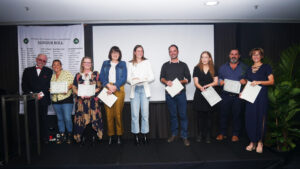
Growing conditions on the shores of the Red Sea are theoretically favourable with plenty of sunshine, however Peter described the natural soil as toxic sand having a high salt content and a pH of 8 or 9. Sandstorms can also make life difficult. To overcome the toxic soil, landscapes must have the top layer replaced with at least 300mm of high-quality landscape soil, and pits greater than 3m3 and provided with drainage, dug for trees and palms. The natural soil provides very little drainage at all according to Peter and turns into a sticky mess with even a small amount of rain.
Originally there were very few plants allowed for import, but with intense lobbying that list has grown to 1250, and thirty of these are palms. About 50% of the plants used in the project are Australian natives, which Peter explained are in the same genera as many of the native species. Acacia and Themeda australis were two examples.
Still, there are many obstacles, such as limited amounts of water and electricity. This area has virtually no infrastructure although a large solar and wind installation, coupled with batteries, is coming online says Peter. Labour is also problematic. The native population in the nearby villages have never had jobs, according to Peter. The area is isolated, but the ambition of the Saudi’s is to educate these villagers to an international standard and provide jobs in service industries, horticulture, tourism, and hospitality.
The projects in Saudi Arabia call for rapid establishment of landscapes and generally the landscapes use advanced plants in large numbers, but as we all know, big trees come from small seeds.
Ian Van Zanten from Ball Australia made the point that what you see in the garden centres and landscapes in Australia today were probably planned for two years previously. Vegetative mass propagation really requires long term thinking, high levels of hygiene, meticulous record keeping, and a level of sophisticated mechanisation.
Some propagators like the challenge of taking plants that are hard to propagate or require innovative methods to get the plants to adapt to a variety of different growing conditions. Tony Hughes demonstrated his passion for propagation and sharing his skills, by demonstrating his grafting techniques during the IPPS tour of the Gordon TAFE, and spoke about his success grafting Eremophila onto Myoporum root stock to provide a plant suitable for the wetter climate around Geelong. It was fantastic to see the old hands guiding the young hands during the grafting workshop run by Tony.
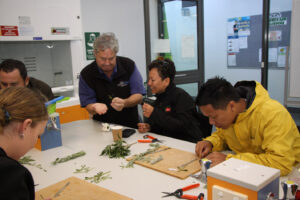
In a similar vein, David Hancock has a passion for environmental restoration, and that has been his core business for over 20 years. During his presentation, David praised the efforts of his staff at Natural Area and stressed the need for rigorous location records when collecting seed from the natural environment. He maintained that seed collected from locations only a few kilometres apart can have different outcomes. This factor is important when trying to re-establish vegetation in disturbed areas. David praised his propagators who, he said, are obsessed with testing and recording best seed and provenance source, collection timings, and germination triggers. David encourages research, experimentation, and radical treatments to achieve germination. Using hard-to-germinate plants could be the key to successful environment restoration and also may provide intellectual property for growers. He encouraged growers and seed collectors to collaborate to maximise success. David compared SIRAS Pacifique to his own organisation based in WA. Both organisations are involved in propagating native flora to repair degraded landscapes.
Marissa Collins, a senior lecturer in agronomy at La Trobe University, is also a researcher interested in understanding plant interactions with the environment to improve crop productivity. She underlined the importance of agronomy because without it, she maintains, you would be naked, hungry, and sober. Plant production is facing the challenges of an increasing global population, limited land, and climate variability so it is important to do much more with much less.
This sentiment was echoed by another presenter, Miguel Meneses who described the reducing availability of peat moss as a growing substrate. Many countries have plans to phase out peat moss use in favour of renewable materials, and now users need to find alternatives.
Peter Lewis made mention of the virtues of peat for establishing plants in a dry climate such as around the Red Sea, and bemoaned the fact that peat is being phased out because of ecological reasons. Peat from Russia and Belarus is now restricted. Using coconut coir, a waste product from other processes, is seen as a substitute but, according to Peter Lewis, it doesn’t have the water holding capacity of peat moss. Wood fibre and pine bark is seen as one alternative in Europe, but wood fibre is currently a restricted import into Australia.
Reducing reliance on finite resources and developing a sustainable circular economy relying on recycling was the subject of Matt Mills’s presentation. Matt is the National Sales and Marketing Manager for Garden City Plastics, but representing Collective Good at this conference he described the sustainable circular model developed by Norwood Industries, Garden City Plastics, and Polymer Processors to continuously recycle the 12 million kilograms of PP5 (polypropylene) products sold by the horticulture industry each year. The greatest obstacle is collecting the material. Black pots are not detected by plastic sorting systems at recycling centres and are sent to landfill. Collection relies heavily on community awareness, over 700 retailer collection sites, and education of, and action by, consumers.
Botanic gardens were well represented at this conference by Andrew Laidlaw, Amanda Shade, Clare Hart, and the staff and friends of the Geelong Botanic Gardens who hosted tours of the garden and an evening BBQ event.
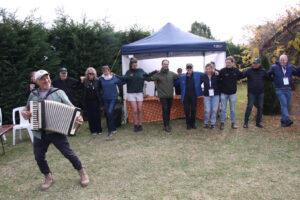
Andrew Laidlaw, Landscape Architect, has designed spaces at Melbourne Botanic Gardens that provide safe, wild places for children and adults to interact with nature. His ambition is to provide spaces for people who do not necessarily have access to green spaces, including sufferers of various medical conditions including Alzheimer’s disease and dementia. He described the White Oak project where a 165-year-old oak tree cracked and dropped its limbs. Rather than just remove the tree and replace it, they decided to use the large fallen limbs to frame a garden meeting place centred around the remaining stump. Andrew has extended that concept off-site to include a ‘calming’ garden installation at the Alfred Hospital in Melbourne, and is currently negotiating to develop a garden for children in Gaza, Palestine.
Amanda Shade, the Manager of Living Collections for the Botanic Gardens and Parks Authority in Kings Park, WA, stated the primary function of botanical gardens is conservation, research, education, and training. By educating the wider community and developing interest in the flora, the more likely people will be in taking ownership of the environment. One of the functions of the nursery is to grow plants for long term restoration projects. Many threatened species require thorough trialling according to Amanda, and we need reliable data on how to propagate before we can recommend them for wider use by the industry and community.
Climate change is affecting the range of many plants and botanical gardens now must consider how it will affect their plant collections. Changes in rainfall distribution and the number of hot days could affect many collections and plants in the wild. Clare Hart is the Horticulture Manager at the Royal Botanic Gardens Victoria, Melbourne Gardens. Clare spoke about the need to adapt the Botanic Gardens in Melbourne to a changing climate. Their research suggests that the Melbourne climate will be warmer and drier than it is now. This has implications for water use and plant survival. In order to maintain the landscape character of the Melbourne Botanic Gardens, the current landscape will need more resilient species suited to the projected climate conditions. Clare listed areas that could provide plants for Royal Botanic Gardens Melbourne and these included areas around Dubbo, Coonabarabran, Orange, and Narrabri in NSW.
Clare also described a free web-based tool to support plant selection and decision making by botanic gardens, arboreta, urban forestry, and horticulture. The Climate Assessment Tool was developed by a collaboration between University of Tasmania, Botanic Gardens Conservation International, and the International Association of Botanic Gardens.
The Rod Tallis Award, named after one of the society’s most respected members, is presented to a person over eighteen years of age and who is working or studying some area of horticulture. Elliot Akintola, working for Garden City Plastics, was the worthy winner and he presented a summary of his research into volatile organic compounds and phosphorous uptake. The ‘take-away’ message was that a comprehensive understanding of how a plant uses volatile organic compounds to establish functional arbuscular mycorrhizal associations will facilitate plant adaptation to climate change. The research provides groundwork for developing non-intrusive methods for early detection of nutrient deficiency, and a method to determine plant health.
We heard from Sizwe Ndabeni and Stephanie Hastie about their exchange experiences between Australia and South Africa which was funded by IPPS.
With every IPPS conference comes tours and social events as well as an awards night and the winners of awards were:
Australian Award of Honour – Ray Doherty
Edward & Mary Bunker Award – Jane Edmanson
Steve Vallance Pewter Tankard Award – Tony Vander Staay
Rod Tallis Award – Elliott Akintola
Anita Boucher Award – Andrew Laidlaw
Unfortunately, Peter Waugh, who has entertained conference delegates over the years with his exceptional auctioneering skills and terrific sense of humour, was unable to attend from New Zealand at the last minute. He was awarded an Honorary Membership.
Of course the tours before and during the conference make for a most enjoyable conference, and this wrap-up barely scratches the surface of the entire conference. I look forward to the next conference in May 2024, in Ballina, Northern NSW.
Main photo: Brice Higgs presenting the Rod Tallis Award to Elliot Akintola, pictured with his wife Joana
(All images supplied by Karen Smith)
